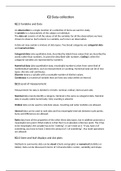Summary
Business statistics Book Summary - IBA VU
- Course
- Institution
- Book
A complete (!) summary of the book Applied Statistics in Business and Economics for the first year course Business Statistics of International Business Administration (IBA).
[Show more]




